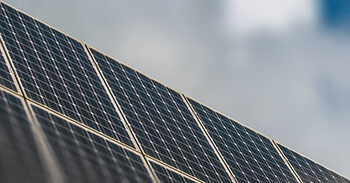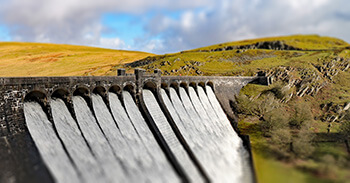Blockchain for electricity and gas: decentralized energy trading

Blockchain represents a new approach applicable to all types of transaction, born out of virtual currencies such as Bitcoin and Ethereum. While the financial sector has taken to the concept very quickly, the energy sector has been more reticent due to restrictive regulations and the segmentation between energy generators, distributors and providers, with each having specific needs from a blockchain system. However, blockchain has great potential for all industry segments and can affect how energy is produced, bought, and sold in far-reaching ways.
What is blockchain?
Blockchain is a way of making and tracking transactions that can be accessed, modified and verified from anywhere without needing special access to a company server or service. Doing business through blockchain does away with the need for middlemen to ensure a transaction is secure and trustworthy.
For example, if you wanted to sell your car online with blockchain you wouldn’t need to go through eBay or another online sales platform. This is because instead of relying on an established service, like Amazon, to process and record the transaction, blockchain is based on a network of computers focused on trading. These computers talk to each other to process transactions and crosscheck details to ensure agreement about the validity of the transactions that have occurred.
The computers being able to verify each others’ records in realtime is crucial. It means there is no longer a need for either a bank or retailer to ensure that the transactions are valid and not fraudulent. That is a unique advantage that blockchain has over the current way of doing things and it means faster transactions, potentially lower costs, and a reduced risk of fraud.
Blockchain is very much like the internet in many ways. However, where the internet was designed from the ground up to share and present information wherever there is a connection, blockchain is solely focussed on transferring value in a reliable yet decentralised way.
Let’s take a look at a typical online transaction and break down what happens when you make a purchase on the Internet to see how it differs from how blockchain works.

When you browse through products on a website, you are viewing information such as price and features: little more than text, pictures and video. Even the notification that states the product is available is just a bit of text that gets changed based on some web code. It’s all just information presented through your internet browser.
You decide to trust this information because you may know the brand or the online shop has some form of standard certification, and you go ahead with the purchase. It is all based on you trusting the information is accurate. However, there is no feasible way for you as a customer to gain direct access to the retailers’ inventory software to actually verify the product is really in stock.
The backbone of blockchain technology is the public ledger, which is constantly being tracked, verified and updated on all participating systems. The public ledger data is available across all the computers yet it is also encrypted and anonymised at the same time. This means that if your computer and the retailer were on the same blockchain, your computer could verify the retailer inventory automatically and conversely the retailer could check you have sufficient funds, without revealing any sensitive information in either direction. This results in the necessary trust being established for a transaction to take place without the need for a central authority or third party to vouch for it.
Blockchain in the renewable energy sector
With the resale of renewable certificates of origin, blockchain has significant potential in authenticating where energy comes from due to its distributed nature; something that the current REGO scheme falls short on. There are two main things needed for blockchain to work in the UK energy sector. The first is agreeing on a blockchain standard across the industry. The second is implementing equipment that can feed the blockchain with information at each stage of the energy value chain (generation, distribution and provision).
Incidentally, smart meters could be the cornerstone of a blockchain system. In fact, by using the information they produce there are over 100 possible applications of blockchain technology within the energy industry alone!
Blockchain helps to distribute energy resources
One very exciting use for blockchain technology is peer-to-peer electricity trading. Namely, the ability for neighbouring customers to trade energy with each other without having to go through a power company.
This is already happening in a neighbourhood in Brooklyn, New York where several flats with solar panels are able to share and trade electricity with neighbours through the power of blockchain.
Residents who own solar panels can sell energy to neighbours who don’t have them or to neighbours who may have wall batteries to store power. This latter group can then, in turn, trade it back to the solar power owners, who may not have a way to store surplus energy for night time use.
Blockchain performs the role of an autonomous accounting system tracking how much energy is available, where it is needed and how much it costs. This lets participants stay supplied without needing a power company to keep track. The additional bonus of schemes such as this one is that they expertly leverage the decentralized potential of renewable energy.

More schemes like this one could mean that fewer people need to rely on utility-scale power stations and the fossil fuels they commonly use.
Another key benefit that blockchain brings to the table is removing, or at least reducing, the likelihood of a single point of failure. Over the past few years, there has been a worrying increase in cyber attacks on national energy infrastructure from power stations to the national grid. With centralized systems, the likelihood of a compromised key component bringing down the entire power grid is exponentially high.
Meanwhile, a decentralized system is hardened against even the most sustained attacks from a peer-state actor or proxy. Blockchain enables the kind of ad-hoc organisation associated with the internet; whose forerunner was designed at the height of the Cold War as a way for nuclear silos to communicate reliably in the event of all-out atomic war taking out central command and control facilities.
Blockchain as a replacement for the Feed in tariff
Earlier this year, the UK government discontinued the Feed-in Tariff scheme for new applicants. The Feed-in Tariff allowed households with rooftop solar panels and other sustainable energy sources to sell any surplus energy back to the wholesale market by feeding it back to the national grid. Blockchain-derived schemes, such as microgrids, can pick up where government incentives left off and incrementally move us to a connected clean energy future.
Blockchain and energy trading
Blockchain’s emergence from the virtual currency and financial sectors make it eminently suitable to help solve the coordination challenges that are inherent across the energy industry.
Future energy challenges
1.Renewables

In 2017, renewable energy sources represented 66% of new generation capacity being developed worldwide. This undeniable momentum has implications for every segment of the deregulated UK energy market because it challenges long held practices and beliefs about how to manage demand over time on the national grid and the role of baseload power plants which more often than not use fossil fuels.
2. Electric vehicles
A whole slew of car manufacturers is following on the coattails of Tesla by adding EVs to their product roster. With overall sales on trend to surpass 10 million by 2025, the charging infrastructure has to scale up efficiently and integrate with the competing priorities involved in load balancing a national electricity grid. Issues such as millions of drivers charging their cars at the same time will need to be confronted sooner than many people think.

These are just two of the challenges that the UK energy sector faces in the coming decade. However, there are opportunities here to work better together and blockchain could be a key component in making improved coordination a reality thanks to its distributed nature.
Using electric car chargers as an example, a blockchain ready charger could autonomously set up a smart contract between it and a power generator to ensure supply for customers without needing human oversight. Human input would be limited to setting up broad parameters for smart contracts while intelligent systems based on machine learning would handle their day-to-day implementation. Computers could seamlessly trade power alongside human operators in the near future.
Proof of work, proof of stake or proof of authority
There are three main business models that secure a blockchain and ensure its successful operation on a fundamental level. On the face of it, these are abstract concepts but they are necessary for establishing the trust necessary for trade on the blockchain. Let’s see how these methods differ and which one is most suited to the wholesale electricity market.
1. Proof of work
This is the system used by Bitcoin and the idea is similar to CAPTCHA (where a trivial task is used to prove you’re human) but for computers in this case. The computer has to solve a moderately complex problem which dissuades would-be attackers from hijacking the blockchain. The issue with this system is that it results in an increase in energy consumption to process these authentication tasks which brings in additional and undesirable costs as well as a negative environmental impact.
2. Proof of stake
Instead of making computers carry out menial math tasks, this system operates through consensus between the various blockchain stakeholders. This method presumes that all participants have the best interest of the blockchain at heart. However, the proof of stake does not account for different human or virtual stakeholders can have varying incentives, affecting their underlying interests and motivations.
3. Proof of authority
This is probably the most traditional approach to building up trust within blockchain participants. Here, transactions are authenticated by certified accounts, called validators, who run software that allows them to add transactions to the blockchain. Validators are incentivised to maintain their accounts in good standing which, in turn, builds trust in the blockchain.
Most companies using blockchain in the energy and smart grid sector are leaning towards the proof of authority model. The primary reason for this preference is its compatibility and flexibility with regards to industry regulation giving government bodies the requisite oversight of the blockchain while maintaining the privacy needed for participants to retain their competitive advantage. It’s also significant that the proof of authority model is as resource-efficient as proof of stake, since both remove the concept of mining inherent in proof of work, making it attractive to energy companies seeking a carbon neutral footprint.
Blockchain energy startups in 2019
Power players big and small are starting to look towards blockchain to solve pressing energy industry problems. Let’s celebrate some of their recent successes.
Electron is a startup that got off the ground in 2016 and is looking to develop a grid coordination marketplace that brings in data from smart devices or the Internet of Things (IoT) to manage electricity purchasing at a much more granular level. This approach could make ‘energy as a service’ a reality with the advent of home energy storage. They received funding from Kaluza, the investment arm of Ovo Energy in March 2019.
Energy Web Foundation has developed an energy trading platform with deep tracking capabilities based on Ethereum blockchain technology. As a proof of concept, they helped Spanish energy giant Iberdrola (the owner of Scottish Power) track energy supply in realtime between a hydroelectric power generation plant in Galicia and the headquarters of two major banks in different regions of Spain.
Centrica, owner of British Gas, needs little introduction. In 2018, the company worked with LO3 energy, the American startup responsible for the Brooklyn energy sharing project, to reproduce the experiment for their Local Energy Market (LEM). This will allow local businesses and consumers to trade energy with the national grid and other participants in the UK. This scheme is welcome news with the recent curtailing of the Feed-in Tariff.
